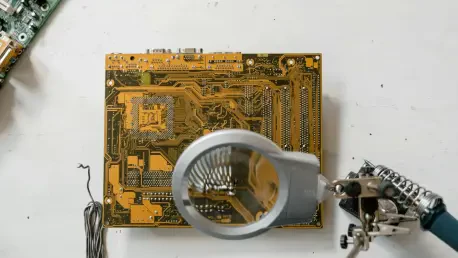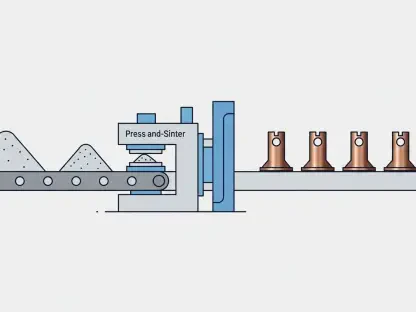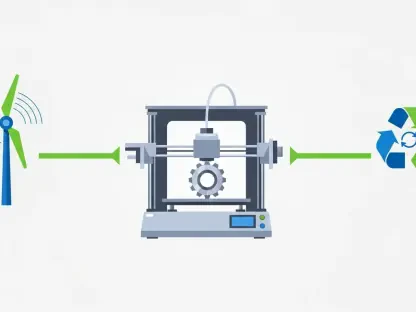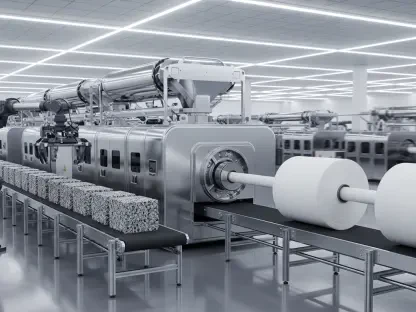In the fast-paced world of semiconductor manufacturing, where precision is paramount and even the smallest deviation can result in catastrophic financial losses, the ability to detect anomalies in real time has become a game-changer. Imagine a production line processing thousands of wafers daily, each undergoing hundreds of intricate steps, only to have a subtle fault slip through traditional monitoring systems, costing millions in yield loss. This scenario is all too common in an industry that generates massive streams of sensor data, from chamber pressures to vibrations, requiring a level of analysis far beyond human capability or outdated thresholds. Enter a cutting-edge solution from NVIDIA, designed to revolutionize how fabs tackle these challenges. NV-Tesseract, a family of models tailored for time-series tasks, offers a powerful framework for anomaly detection, classification, and forecasting, promising to transform raw data into actionable insights. This technology, delivered through NVIDIA NIM microservices, is setting a new standard for efficiency and precision in one of the most data-intensive industries on the planet.
1. Unveiling a Versatile Framework for Time-Series Challenges
Semiconductor manufacturing stands as a cornerstone of modern technology, yet it grapples with unparalleled data complexity that demands innovative solutions. NV-Tesseract emerges as a family of models engineered to address diverse time-series tasks, including anomaly detection, classification, and forecasting, all within a unified framework. This adaptability is crucial for industries where data evolves constantly, and nowhere is this more evident than in semiconductor fabs. These environments produce vast amounts of dynamic information that traditional systems struggle to interpret effectively. By offering a general-purpose backbone, NV-Tesseract can be tailored to specific industrial needs, ensuring that subtle deviations are caught before they escalate. This capability not only enhances monitoring precision but also paves the way for broader applications across sectors facing similar data challenges, making it a versatile tool for future advancements in industrial automation.
The significance of NV-Tesseract lies in its ability to integrate seamlessly into existing systems while pushing the boundaries of what anomaly detection can achieve. In semiconductor manufacturing, where every wafer’s journey through production is meticulously tracked via multiple sensors, the stakes are incredibly high. A single oversight can disrupt entire batches, leading to substantial financial setbacks. NV-Tesseract’s framework is designed to process and analyze time-series data with a level of granularity that outdated methods cannot match. It focuses on identifying patterns and irregularities across diverse datasets, ensuring that even the most context-dependent anomalies are flagged. This approach represents a shift from reactive to proactive management, allowing manufacturers to maintain control over their processes. As a result, the technology promises to redefine operational standards, delivering both reliability and efficiency to an industry under constant pressure to innovate.
2. Navigating the Complexities of Wafer Production
Semiconductor manufacturing is a labyrinth of precision, with each wafer undergoing hundreds of tightly controlled steps, generating enormous volumes of sensor data such as chamber pressures, gas flows, RF power levels, and vibrations. This data deluge poses a significant challenge, as even minor deviations can signal impending faults that threaten production integrity. Traditional monitoring systems, often reliant on fixed thresholds and statistical process control (SPC), fall short in detecting subtle or context-dependent anomalies. These systems typically trigger alarms only after issues have escalated, forcing a reactive stance that can be too late to prevent damage. The inability to adapt to process drifts or recalibrate thresholds dynamically means that critical faults often go unnoticed until they impact yield, underscoring the urgent need for more advanced detection mechanisms in this high-stakes environment.
The financial ramifications of undetected anomalies in semiconductor fabs are staggering, with a single missed fault potentially leading to yield losses worth millions of dollars, and beyond the immediate cost, such oversights can disrupt supply chains and delay product deliveries in an industry where timing is critical. Traditional SPC methods, while useful for basic oversight, lack the sophistication to analyze interdependent sensor signals comprehensively. This gap often results in production continuing uninterrupted despite underlying issues, compounding the damage. The complexity of modern chipmaking, with its intricate recipes and tight tolerances, demands a solution that can keep pace with data scale and variability. Addressing these challenges requires a shift toward real-time, intelligent monitoring capable of identifying problems at their inception, thereby safeguarding both output and profitability in a sector where margins are razor-thin.
3. Transforming Detection with Real-Time Localization
NV-Tesseract, delivered as an NVIDIA NIM microservice, marks a significant leap forward in anomaly detection by enabling real-time localization within time-series data across both single signals and multiple correlated sensors. This precision is vital for semiconductor fabs, where pinpointing the exact moment an anomaly begins allows for immediate corrective action. Unlike traditional systems that offer vague alerts after the fact, this technology identifies specific timestamps where deviations occur, ensuring that only wafers processed post-anomaly require scrutiny. Such granularity minimizes unnecessary halts in production and focuses resources on genuine issues. By providing this level of detail, NV-Tesseract empowers manufacturers to respond swiftly, preventing faults from cascading downstream and protecting the integrity of entire production runs with unprecedented accuracy.
The shift from after-the-fact inspection to proactive anomaly localization redefines how fabs manage quality control, offering substantial benefits in yield protection and cost reduction. By transforming raw sensor noise into actionable insights, NV-Tesseract ensures that potential losses are mitigated before they spiral out of control. This approach also lays the groundwork for more intelligent automation at scale, as real-time data analysis becomes a cornerstone of operational strategy. Fabs can now integrate continuous monitoring into their workflows, reducing reliance on manual interventions and post-production checks. The result is a more streamlined process that not only saves money but also enhances overall efficiency. As semiconductor manufacturing continues to push technological boundaries, tools like NV-Tesseract are essential for maintaining competitiveness in an industry where every second and every wafer counts.
4. Decoding the Data Landscape of Semiconductor Fabs
Semiconductor manufacturing ranks among the most data-intensive industrial sectors globally, with each wafer navigating hundreds of precise steps while tools stream data from dozens, if not hundreds, of sensors. This environment produces not only vast data volumes but also interdependent signals that require multivariate analysis to uncover hidden issues. A deviation in a single sensor might appear trivial in isolation, yet when correlated with others, it could indicate the start of a severe fault. This complexity necessitates advanced systems capable of synthesizing diverse data points into a cohesive picture. Without such capabilities, manufacturers risk missing critical warnings embedded in the noise, highlighting the importance of sophisticated analytical tools that can handle the scale and intricacy of fab data with precision and reliability.
Common anomalies in fab data further illustrate the challenges at hand, ranging from baseline changes signaling calibration shifts or tool drift to sudden spikes indicating instability in plasma sources or gas flows. Sensor malfunctions, where outputs flatline or lock at unrealistic values, pose silent threats by obscuring the true state of processes. Additionally, magnitude jumps in sensor readings often stem from misconfigurations or early hardware failures, disrupting expected patterns. Each of these issues, if left unchecked, can compromise entire wafer batches, leading to significant losses. Addressing them requires a detection system that not only identifies deviations but also understands their context within the broader data ecosystem. Such comprehensive analysis is critical for maintaining production quality in an industry where even minor errors carry outsized consequences for both output and bottom-line results.
5. Gaining Precision through Dataset Evaluations
Testing NV-Tesseract on semiconductor fab datasets has revealed a critical insight: anomaly localization is just as important as detection itself, providing a significant advantage in manufacturing processes. Traditional SPC charts and tool alarms often raise flags without specifying when a process veered off course, leading to broader scrapping of lots or more costly re-inspections than necessary. NV-Tesseract addresses this gap by identifying the precise timestamp at which an anomaly begins, offering a clear decision point for manufacturers. Wafers processed before this moment can frequently be salvaged, while those after warrant closer examination. This level of detail transforms anomaly detection from a generic alert into a targeted tool for yield management, enabling fabs to focus efforts where they are most needed and avoid overreacting to non-critical signals with wasteful measures.
The dual impact of NV-Tesseract’s precision is evident in both reduced waste and enhanced operational efficiency, making it a game-changer for modern manufacturing. By limiting the volume of product discarded due to suspected faults, manufacturers can preserve valuable resources and maintain higher output levels. Simultaneously, the ability to implement corrective actions in near-real-time keeps equipment operational and prevents defects from propagating through production lines. This proactive approach not only protects yield but also drives down costs associated with downtime and rework. Furthermore, NV-Tesseract complements existing fab alarms by adding contextual intelligence, allowing for more decisive and informed responses. The result is a monitoring system that aligns with the fast-paced demands of modern manufacturing, ensuring that every anomaly is addressed with the urgency and accuracy required to sustain competitive performance.
6. Streamlining Deployment with Advanced Microservices
Deploying cutting-edge anomaly detection models in semiconductor manufacturing requires more than just innovation; it demands seamless integration into existing production systems. NVIDIA NIM, a component of NVIDIA AI Enterprise, addresses this need as a set of microservices designed for secure and reliable AI model inferencing across workstations, data centers, and cloud environments. Supporting a wide range of AI models, NIM facilitates containerized deployment in minutes via the NVIDIA NGC Catalog, ensuring consistent performance whether on-premises or at the edge. Its scalability, bolstered by orchestration frameworks like Kubernetes, allows for managing hundreds of microservices, while built-in health checks, monitoring, and enterprise support guarantee reliability. This infrastructure makes advanced detection accessible without the burden of extensive engineering efforts.
For semiconductor fabs, NVIDIA NIM simplifies the transition of NV-Tesseract from research prototypes to scalable production deployments, eliminating the need for custom packaging or fragile integrations. This streamlined process means that manufacturers can quickly adopt sophisticated anomaly detection without disrupting ongoing operations. The microservice approach ensures that NV-Tesseract operates efficiently across diverse environments, adapting to specific fab requirements with minimal friction. Additionally, the robust security and continuous validation offered by NIM protect sensitive data and maintain system integrity, addressing critical concerns in high-stakes industries. By bridging the gap between theoretical advancements and practical application, this deployment framework empowers fabs to harness AI-driven insights, enhancing both precision and responsiveness in their anomaly management strategies.
7. Simplifying Installation with a Guided Workflow
Implementing NV-Tesseract in semiconductor fabs is made straightforward through a well-defined deployment workflow using NVIDIA NIM containers, ensuring a smooth integration process. The process begins with retrieving the NV-Tesseract container from the NVIDIA NGC Catalog using the command docker pull nvcr.io/nim/nvidia/nv-tesseract:. Next, launch the container with GPU support by executing a docker run command that specifies ports and includes an API key, ensuring secure access. Local data directories are then mapped to the container workspace for seamless input processing. Finally, handle input and output in CSV or JSON formats for time-series data, with outputs providing timestamps, sensor values, anomaly scores, and diagnostics. This structured approach ensures that even complex AI models can be integrated into production environments with minimal technical hurdles, facilitating rapid adoption.
Further clarity comes from the JSON input and output formats used in this workflow, designed for ease of use. Inputs consist of multivariate time-series data with elements like timestamps in ISO-8601 format and numeric sensor readings, ensuring seamless data handling. Outputs mirror this structure, adding an anomaly flag—0 for normal and 1 for anomaly—alongside timestamps and values, enabling precise identification of issues. This compatibility with standard data formats simplifies integration with existing fab systems, ensuring that data flows smoothly between processes. By providing a clear and efficient deployment path, the workflow minimizes setup time and technical barriers, allowing manufacturers to focus on leveraging NV-Tesseract’s capabilities. The result is a practical solution that aligns with operational needs, delivering actionable insights without the complexity often associated with advanced technology rollouts.
8. Converting Data Noise into Strategic Advantages
Semiconductor fabs generate torrents of sensor data—pressures, flows, temperatures, and vibrations—each a potential indicator of trouble, yet traditional fixed thresholds and manual rules struggle with the noise and scale of modern chipmaking. NV-Tesseract, supported by NVIDIA NIM, offers a roadmap for overcoming these limitations through fine-tuning on fab-specific data, allowing the model to adapt anomaly definitions to individual tools or production lines. Additionally, hyperparameter tuning provides adjustable settings for balancing precision and recall, aligning detection sensitivity with operational priorities. These advancements ensure that anomaly detection evolves beyond generic alerts, delivering tailored insights that address the unique challenges of each manufacturing environment and enhancing overall process control.
Deployment via NIM translates these capabilities into tangible benefits, such as protecting wafer yield by catching subtle deviations early, minimizing downtime through immediate detection of sensor issues, and building engineer trust by reducing false positives while highlighting critical events. Furthermore, it enables scalable intelligence across multiple tools with minimal integration effort, unifying anomaly detection capabilities across entire fleets. This comprehensive approach not only prevents yield loss from plasma or temperature deviations but also curbs extended outages from unnoticed calibration drifts. By turning noisy signals into actionable strategies, NV-Tesseract equips fabs to maintain high standards of quality and efficiency, ensuring that every production run benefits from cutting-edge monitoring tailored to specific operational demands.
9. Taking the First Steps toward Enhanced Monitoring
Semiconductor fabs faced formidable data challenges, but NV-Tesseract, paired with NVIDIA NIM, provided a pathway to move advanced anomaly detection from research to production in mere hours. Reflecting on past implementations, the technology demonstrated its capacity to address complex issues with speed and precision, offering a glimpse into how real-time monitoring could reshape industry standards. The ability to pinpoint anomalies with exact timestamps allowed manufacturers to mitigate risks before they escalated, preserving both yield and resources. This marked a significant departure from the reactive methods that once dominated, setting a precedent for proactive management that prioritized efficiency. The lessons learned from these early deployments underscored the value of integrating intelligent systems into high-stakes environments, proving that innovation could deliver measurable impact.
Looking ahead, the next steps for fabs involve a clear process to access and test NV-Tesseract NIM, starting with requesting early access through the NVIDIA DGX Cloud team. Once obtained, the containerized service can be deployed in on-premises, cloud, or edge setups, tailored to specific needs. Testing with proprietary sensor data offers insights into how effectively anomalies are detected, while scheduling a demo or discussing time-series requirements ensures seamless integration into existing workflows. These actionable measures provide a foundation for fabs to build smarter monitoring systems, reducing waste and enhancing operational resilience. By embracing this technology, manufacturers position themselves to tackle future challenges with confidence, leveraging AI-driven solutions to maintain a competitive edge in an ever-evolving landscape.









